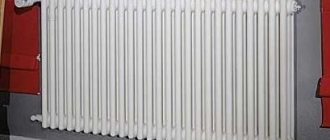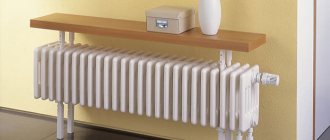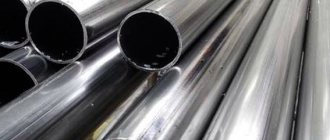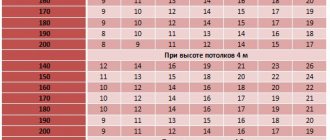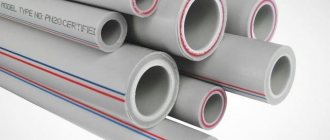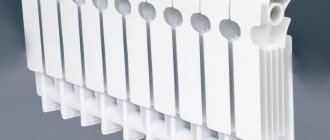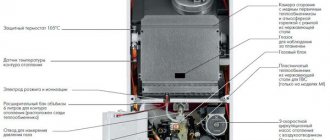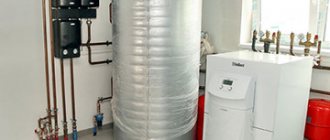Distinctive features
The buyer will never be able to distinguish between an aluminum alloy and a bimetallic one when choosing, because visually they are simply identical sections of radiators, covered with identical paint and varnish material. Therefore, you cannot do without a sales consultant and studying documents for goods in a shopping center. As for the fundamental differences, here the buyer will be faced with a number of physical and technical characteristics of each material.
Manufacturing option
Aluminum products are sections assembled together, assembled with special fasteners and gaskets. Nipples and seals ensure the tightness of the structure. The technology increases heat transfer to 50 cm2.
- Casting. The technology allows, under pressure, to obtain products with excellent resistance to any external or internal (water hammer) influence. Molded batteries are very precise in shape.
- Extrusion. This option is cheaper than the previous one, but the material characteristics are worse.
Light metal option Source tengrinews.kz
Bimetallic radiators are made from two types of raw materials. The ribbed body is made of aluminum. A core of pipes is installed inside the structure, through which the coolant from the heating system passes. Most often, containers are made of steel, less often – copper. The diameter of the structure is smaller than that of models made of one type of metal.
Design features Source santehservis.dp.ua
By heat transfer
Before distinguishing an aluminum radiator from a bimetallic one, you need to understand the features of the comparison indicator. Heat transfer is a criterion indicating the amount of thermal energy that a battery transfers to the air per hour. The higher the parameter, the faster the room heats up.
The heat output of aluminum radiators is from 200 W, 50% of the energy comes in the form of radiation, the rest by convection. The ribbed inner surface of the sections increases readings. After turning on the heating, a standard-sized room will warm up in 10-15 minutes, which saves time and fuel in a country house.
Radiator in the room Source lucheeotoplenie.ru
Due to the design features of bimetallic radiators, heat transfer is lower. The steel core reduces the overall performance by 1/5 of that of an all-aluminum model. The energy carrier in batteries made of two metals does not provide instant heating of the room.
For resistance to water hammer
Water hammer is a physical phenomenon in which the pressure in a particular area increases sharply. When water moves in the heating pipes, obstacles appear, which leads to an abrupt stop. Under the influence of the pumping force, the pressure inside the system increases. The liquid rushes to areas with less resistance, and this leads to damage (bursts) of utility networks.
Device in the room Source trubamaster.ru
Aluminum radiators are resistant to water hammer within 6-16 atmospheres. If there are sudden surges in the heating system, the batteries will burst, and boiling water will begin to flood the apartment and neighbors. Craftsmen do not recommend using such models in old panel houses.
Bimetallic structures have a strong steel core inside. The material is resistant to high pressure, so it will withstand water hammer within 20-40 atmospheres. Radiators are reliable and safe for use in old and new high-rise buildings.
Corrosion resistance
The water in the city heating system consists of many chemical additives that improve thermal conductivity. The components are safe for outdated cast iron models, but negative consequences are possible in modern ones. Impurities are deposited on the walls of the batteries, which leads to corrosion.
Aluminum radiators can withstand pH levels up to 8 units. In old multi-story buildings, the indicator in the pipes is in the range of 10-12. As the parameters increase, destructive reactions begin at the connecting points, which lead to depressurization.
Heating system design Source ukrxoztorg.com.ua
Bimetallic radiators are less demanding on the pH level of water than aluminum types. Due to the design, only the core comes into contact with moisture. Steel has low activity in relation to the chemical structure of the liquid in the heating system. In high-quality models, manufacturers additionally protect the inner surface with an anti-corrosion layer.
Relative to temperature
Cast iron radiators operated with temperatures within 150 C. Aluminum batteries can withstand hot water up to 110 C. To prevent this problem, a built-in thermostat is often installed in the design to regulate modes. The maximum value for bimetallic species is 130 C.
For ease of installation
Due to their low weight, both varieties have basic installation. During installation, massive brackets are not used, as for cast iron models. The equipment can be mounted on a plasterboard partition without fear of destruction or subsidence.
Aluminum structures can crack or become deformed if installation instructions are not followed. Alloy options are more resistant to mechanical influence. To prevent devices from malfunctioning, installation should be entrusted to specialists.
By service life
The durability of the equipment depends on the type of construction. Bimetallic radiators, subject to installation rules and regular maintenance, will last at least 25 years. The most expensive aluminum models will last within 10-15 years under the same conditions.
By price
Bimetallic radiators contain steel, so the finished product is 20-30% more expensive than aluminum structures. Often the price tag of a branded one-component model is lower than that of a “nameless” bimetal structure. The difference in price appears due to the high cost of operation.
What to focus on when choosing aluminum and bimetallic radiators?
When choosing any type of radiator, you should always listen to the advice of experienced experts. So, there are several points that you need to pay attention to.
- Coolant acidity . If you still plan to take a risk and install aluminum batteries in the apartment, then it is worth considering one more factor - the acidity of the coolant in a particular heating system. This indicator is usually abbreviated pH.
For Russian heating systems, the acidity standard is set at 6.5 to 9 pH. The ideal indicator of this parameter is 7 - an almost neutral environment. Everything below 7 is an acid, and everything above is an alkali. If the batteries are silumin, that is, they are an alloy of aluminum and silicon, then they can last long enough only if other parameters are met - temperature and pressure conditions. So, before purchasing batteries, it is worth clarifying what these indicators are for the coolant used in the heating system. Then, these indicators need to be compared with the characteristics indicated in the passport of the selected product. The permissible acidity level for aluminum radiators is 6.5÷9 pH, and for bimetallic batteries 6÷10.5 pH.
- Section weight . The thick walls of the aluminum radiator indicate the reliability of the device, as the risk of leaks in the event of water hammer is reduced. According to the laws of physics, thick and wide section petals provide greater heat transfer than thin ones. From this it should be concluded that a high-quality radiator cannot be excessively light, therefore this quality cannot in any way be attributed to the advantages of the heating device. A manufacturer who tries to save on the thickness of its walls or heat transfer fins by reducing the weight of the battery significantly reduces both heat transfer and overall reliability.
- Quality of threaded connections. It is very important to pay attention to the end of the thread of the outer sections - the turns should not be filled with paint. If this is discovered, it is recommended to refuse to purchase such products. Clean threaded pairs will provide a more reliable connection of the radiator with other elements of the heating system circuit. If the thread is filled with paint, then it will have to be cleaned before installation, which cannot be done perfectly. In addition, such a sign indicates an insufficient technical culture of production, which also leads to far-reaching conclusions.
Be sure to check the quality of threaded connections of sections
- Vertical channel. When choosing a radiator, you must definitely check with your sales consultant what design the vertical channel has. The wider it is, the thicker its walls and the heat exchange fins adjacent to it, the higher the heat transfer, and the lower the likelihood of blockages.
- Surface painting . When purchasing a radiator, you need to remove it from the packaging and conduct a thorough inspection of the outer covering. It is unacceptable for the surface to have roughness (shagreen), sagging enamel, ingrained grains of sand or burrs. In addition, the paint layer should not be too thick to the touch, as it significantly reduces heat transfer, and over time, it may begin to peel off. In addition, mechanical damage to sections can be masked under it. All these surface imperfections indicate low quality products and dishonesty of the manufacturer, so it is better to discard such products immediately.
- Documentation. To purchase quality products, it is recommended to purchase radiators from a well-known manufacturer, who has been working in this field for a long time and values its reputation, and its products have passed the full test of time. In the store, you should definitely read the quality certificate, and also find out who you can contact in case of problems with the radiator, what the warranty conditions are, and how service is established in the region.
In addition, you should ask whether the product is insured, as this is an indicator of its quality and the responsibility of the manufacturing company.
You might be interested in information on how to paint a battery
What about the thermal power of the battery?
The list of evaluation criteria did not mention the required thermal power of the radiator. This was done intentionally, since this calculation has received a lot of attention in other publications on our portal. In particular, a convenient universal calculator for calculating the power of a heating battery for a specific room, taking into account all its features, is given in the article on vertical radiators for an apartment .
The choice of any elements of the heating system must be approached with full responsibility. You cannot purchase heating devices for operating conditions that are clearly unsuitable for them, which can quickly damage the batteries. Moreover, having seemingly saved on inexpensive radiators, you can be left with a very large expense - in the event of a very likely emergency, you will have to shell out a larger sum, especially if, in addition to your own apartment, the one located on the floor below will also be flooded. Therefore, when buying heating radiators, you must immediately calculate all possible negative consequences and make the right choice. Fortunately, there are opportunities for this.
As another useful hint, here is a video comparing aluminum and bimetallic radiators. Study long-burning cast iron boilers at the link.
Pros and cons of radiators
The experience of professionals suggests that there is no universal heating equipment. When choosing batteries, users pay attention to design and price, but exclude technical features. Before you distinguish an aluminum radiator from a bimetallic one, you need to understand the pros and cons of both types.
Aluminum
Batteries are made from an alloy of metal and silicon. Silumin retains the positive characteristics of aluminum, while increasing resistance to adverse conditions. The advantages of the equipment include:
- High heat transfer coefficient. After turning on the heating, aluminum radiators will warm up the room in a few minutes. The devices are very hot to the touch, so they are often hidden under protective screens to prevent accidental burns.
- Compactness. The dimensions and weight of the battery are much smaller than those of cast iron. When installed correctly, the structure does not protrude beyond the window sill.
- Affordable price. The equipment has low cost.
- Changing the number of sections. In cast models, elements can be added or removed.
- Temperature regulation. The user independently adjusts the comfortable parameters for the room.
- Stylish design. The elegant design will fit into the interior of any room.
The models are very dependent on water quality. Hydrogen accumulates in aluminum radiators. If gas is not periodically removed from the heating system, an explosion is possible. Special air vents break down quickly, so you need to regularly monitor the condition of the filters. If the pH level in the liquid becomes within 8 units, then there is a risk of corrosion. Rust corrodes the joints, which manifests itself in the form of leaks.
Warm compact design Source vchaspik.ua
Installation of aluminum batteries should be carried out by professionals. At the slightest violation of installation rules, radiators become deformed and fail. When connecting to pipes made of another metal, a corrosive reaction is possible, so similar or plastic types are used.
Bimetallic
Steel and aluminum are used in the production of heating equipment. The upper body provides thermal conductivity, the internal parts are responsible for resistance to destructive reactions and water hammer. The positive aspects of bimetallic radiators include:
- Long service life. Due to the internal steel pipe, the device does not lose its original characteristics for 25 years.
- High maximum temperature. Bimetal can withstand 130 C (aluminum - 110).
- Resistant to pressure surges. It does not collapse under water hammer up to 40 atmospheres, although in the heating system of a high-rise building the indicator does not rise above 20.
- High quality coverage. Models are painted in 2 stages (paint, polymer epoxy), which increases the tightness and decorativeness of the structure. A boring color can be repainted.
- Use in damp areas. The external sheet covering protects the equipment from corrosion.
- Easy installation. Sections can be extended on site.
A reliable bimetallic battery is not destroyed by the chemical composition of water in the pipes. The weak point of the radiator is simultaneous contact with liquid and air, which provokes corrosion on the steel surface. The danger arises when draining moisture at the end of the heating season or when the system in the dacha is standing still.
The bimetallic model has a smaller pipe cross-section than the aluminum one. Due to the complex design, the internal usable area is reduced. Small particles from the heating line under the influence of high temperature clog the narrow opening.
Model in the interior of a room Source santreyd.ru
Steel and aluminum have different thermal expansion coefficients. Due to the mismatch in the system, loud crackling sounds occur. Bimetallic radiators have good heat transfer. When the heat is turned on, the room heats up quickly and evenly. Due to the complex manufacturing technology, the price of the models is much higher than that of aluminum types of the same size.
Advantages of bimetallic batteries
An important advantage that allows you to save energy resources is the small internal volume of the bimetallic radiator. This means that these devices require a small amount of coolant. This does not affect the intensity of air heating in the heated room. The aesthetic appearance of the products will fit perfectly into any interior.
List of advantages of bimetallic radiators:
- The product can withstand any pressure in the system;
- when comparing how bimetallic heating radiators differ from aluminum ones, it should be noted that they can be installed in heating systems with any acid-base balance of the coolant;
- the connections of the sections are very reliable (paronite seals are used);
- large margin of safety of the product;
- the appearance does not deteriorate over time due to durable coloring;
- bimetallic radiators serve for more than a quarter of a century due to the use of steel pipes in the design;
- have maximum heat transfer due to aluminum fins.
For reference. Installing such radiators is not difficult. If necessary, you can build up additional sections without removing the already installed radiator. This is very convenient when the heating system has already been installed, but the decision has been made to enlarge the radiator.
Which to choose
Despite the apparent similarities, both types of batteries have different characteristics. Some are suitable for high-rise buildings, others for country buildings with individual heating. When choosing aluminum or bimetallic radiators, you need to understand what is best for an apartment and what is best for a private house.
To the apartment
Multi-storey buildings are connected to central heating. The pressure in the pipes can change dramatically, ranging from minimum to maximum values. Instability leads to water hammer, which not all metals can withstand.
The water temperature in the system changes dramatically throughout the day or the entire heating season. The chemical structure of the coolant in a high-rise is not ideal. The liquid contains reagents, abrasive substances, and the pH level is higher than the maximum norm (8 units). Components accumulate on the internal walls of equipment, which leads to depressurization and ruptures.
Option for apartments Source djoul.ua
When choosing aluminum or bimetallic radiators, you need to know which model made of two metals is better for an apartment. The structure with a steel core will withstand high pressure testing and operating pressure, avoiding accidents. To minimize the aggressiveness of the chemical composition of water, you need to choose devices with stainless steel coating of internal parts.
Bimetallic sectional models are recommended for installation in apartments of new high-rise buildings. The devices, which are undemanding to the quality of the coolant, are easy to install. For old buildings, preference is given to monolithic options. Due to the reinforced design, the batteries will withstand the maximum load and will not burst from a powerful water hammer. The heating equipment is protected from leaks by a solid steel core.
Convenient bimetal model Source skspec24.ru
To a country house
Understanding the difference between an aluminum radiator and a bimetallic radiator, it is easy to choose a solution for a cottage. In a suburban building there is an individual heating system (boiler), which provides constant pressure. The readings in the pipes do not exceed 10 atmospheres, so there are no sudden changes or water hammer.
Aluminum model for a cottage Source rapidly.ru
Positive properties of aluminum batteries
Aluminum radiators are light and durable, easy to transport and install. In addition, they also have a number of important advantages:
- small sizes (shorter in width compared to cast iron);
- very high level of heat transfer;
- operating pressure corresponding to the needs of modern heating systems;
- you can select a product with a certain number of sections according to the heated area;
- good heat transfer, which means efficiency;
- the ability to adjust the temperature using built-in thermostats;
- excellent aesthetic appearance.
The advantages of aluminum radiators over bimetallic ones are their lower price, which is very important for the consumer.
How to distinguish
Externally, both types of batteries are very similar, so problems arise when choosing. Knowing how to visually distinguish an aluminum radiator from a bimetallic one, you can independently choose the appropriate model for your home or apartment. There are signs that allow you to quickly determine the type of equipment you need.
Section options Source otoplenie-expert.com
Pure aluminum batteries are lighter in weight than bimetal structures. Sections of the same size and shape will vary in weight. The steel core is 0.5 kg heavier than one-piece models.
How to choose a design Source yandex.ua
In order not to confuse structures made of different materials, professionals recommend inspecting the threads. In a bimetallic radiator, in areas where water passes through, the integrity of the structure is noticeable. A silvery layer of aluminum is visible on the gray surface of the steel pipe. There is a color transition between the two metals.
Understanding how to distinguish an aluminum radiator from a bimetallic one visually, you can determine the desired model by ear. If you knock on steel, the sound will be loud. The one-piece design produces a dull tone. The check is carried out with a wooden pencil, nail or plastic pen.
How not to make a mistake with the view Source pirco.ru
A magnet will help you find out the type of material. The internal steel filling attracts the device, but aluminum has no attraction. The device is brought closer to the center of the structure, where the metal pipe is located.
Which aluminum radiators are better: casting or extrusion
The characteristics of the equipment largely depend on the method of its production. There may be two of them.
Liteva
Involves the use of silumin, an alloy of aluminum and silicon. It is more durable than “pure” metal. The melt is poured into prepared molds, where it cools. The result is separate sections, which are subsequently welded in an inert gas environment. This technology guarantees high strength of the product.
Cast models are characterized by tightness and reliability of connections, and are characterized by high operating pressure. If necessary, the number of sections can be increased or decreased. It is better to have specialists do this work. A significant disadvantage of the device is its high cost, which is determined by the complexity of production.
Instagram termoros_official
Injection molding models are reliable and durable, they can be installed in high-pressure systems. Their cost is noticeably higher
Extrusion
The method appeared as an alternative to casting in order to reduce production costs. The parts are not cast, but pressed using an extruder. It seems to squeeze out the metal, giving it the desired shape. The finished elements are pressed into cast manifolds. This is how the section turns out. To align them, threaded connections with gaskets or composite glue are used for the most inexpensive models.
The main advantage of extrusion varieties is their low price. Their heat transfer is slightly higher due to the use of recycled metal as a raw material. But this is not significant. But the strength is lower for the same reason. The tightness is also worse, since the gaskets may fail. Composite glue is also not very reliable. Despite the fact that the design is sectional, adding/subtracting elements is not recommended.
Instagram radiator.club
Extrusion radiators are made from recycled aluminum. They are noticeably inferior in strength to injection molded ones.
Opinion of experts and consumers
True professionals can equally easily install both old cast iron batteries and modern lightweight ones made of non-ferrous alloys. For them, as they say, the consumer’s desire is the law, and the latter’s choice is often unpredictable.
Using the language of dry numbers, combined devices confidently come out on top. In this case, the solution to the dilemma: bimetallic or aluminum radiators - which is better - is facilitated by comparing technical data.
- Firstly, heat dissipation. Aluminum is at its best here: one section emits up to 200 W of energy, bimetal is approximately 20% less.
- Secondly, corrosion and mechanical resistance. Hot water, saturated with salts and a fine suspension of metal particles, will quickly undermine soft non-ferrous metal, while a steel core can easily withstand such tests.
- Thirdly, this is the ability to perceive water hammer - a common phenomenon in domestic networks. Aluminum may one day fail and leak, but steel can withstand pressure changes over a long period.
- Fourthly, if we are talking about time, then in relation to the period of reliable operation and the task: which radiator is better - aluminum or bimetallic, the second proposal definitely looks more tempting.
Important. Non-ferrous metals survive safely in aggressive environments for an average of 10 years; a bimetal reinforced with a steel core can last 2 times longer. And the union of 2 metals is able to withstand temperatures up to 130 ºС, as well as much greater pressure, compared to aluminum.
Some consumers complain that “unclean” radiators combined from aluminum and steel give off heat worse, but under the weight of arguments about their undoubted durability, maintainability, and reliability, they change their opinion to the opposite. Ultimately, heat transfer is determined by the temperature of the carrier - if it is obviously low, then no modern materials can help.
Additional selection conditions are set by the profile of the heating system: will it be a general building network, a single network for several apartments, or an individual, local one. In the latter case, if stable pressure in the line is ensured and the coolant is cleaned, the use of aluminum radiators is allowed.
